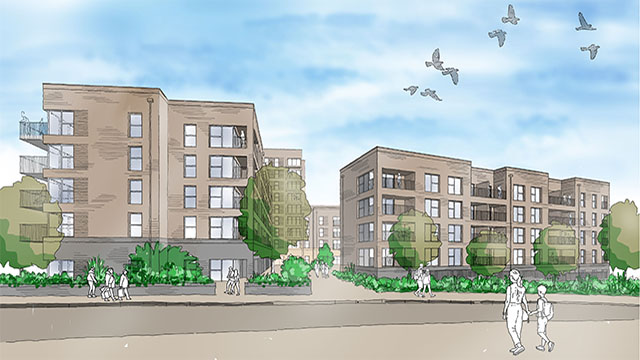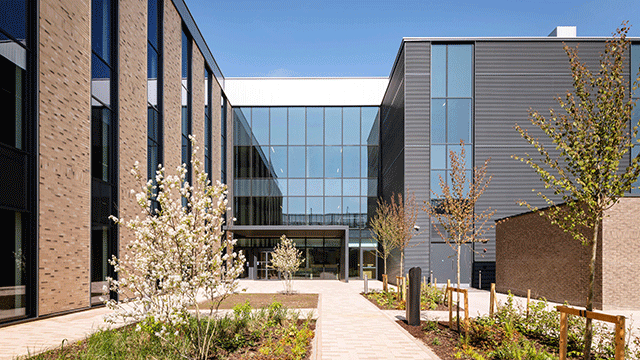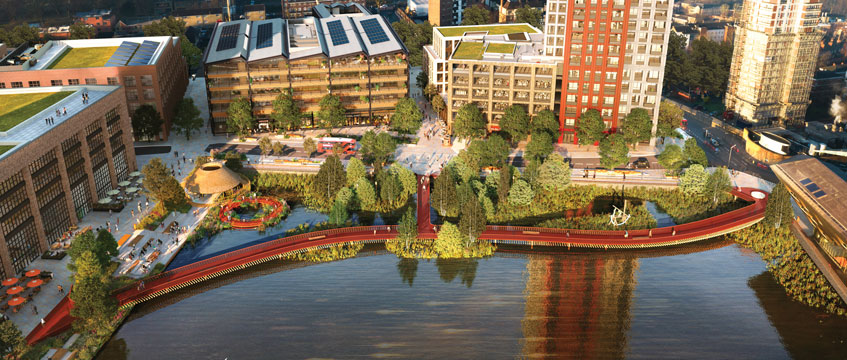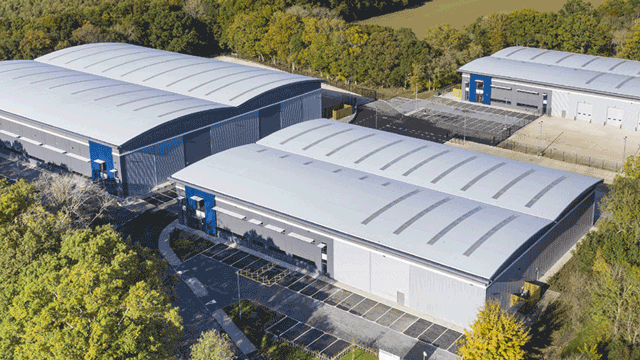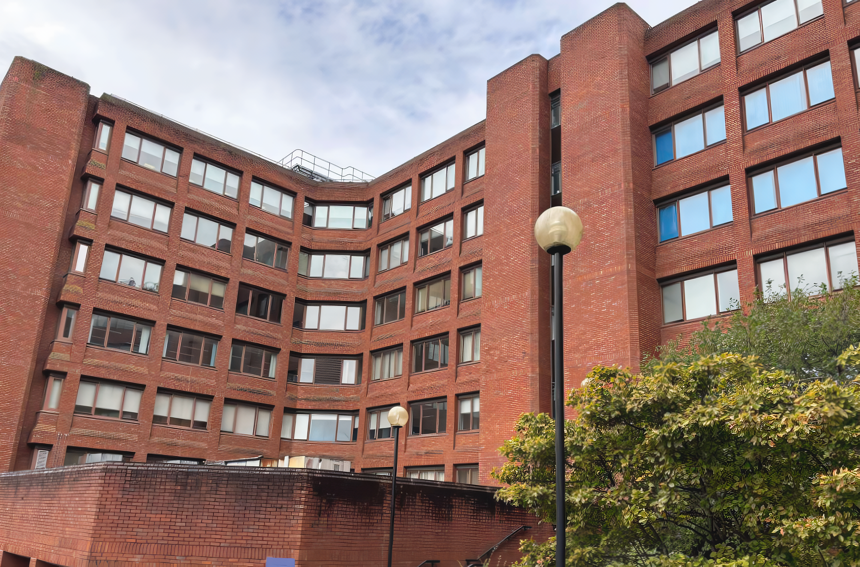British Land’s £3.5bn Canada Water regeneration scheme is set to alter the map of south-east London. Emma Cariaga, the project’s co-head, and office leasing lead Mike Wiseman tell Tim Burke about trying to stay flexible while the world shifts around them.
Emma Cariaga jokes that British Land’s £3.5bn-plus regeneration of Canada Water has the FTSE 100 REIT “bravely” venturing south of the River Thames on a scheme for the first time. But if “brave” is something of an exaggeration in describing plans at the 53-acre site, “bold” is not.
While British Land has long espoused the benefits of its campuses – office-led sites in the City of London’s Broadgate, Paddington Central and Regent’s Place – Canada Water will be something different. Yes, the company is describing it as a campus. But Cariaga, joint head of the development alongside Roger Madelin, goes further, labelling it a new town centre for London and the capital’s “first net-zero neighbourhood”.
The pandemic has reshaped so much of the real estate landscape, and Canada Water is no exception – British Land has been rethinking some design choices during the past two years and has built in flexibility to the heart of its plans for the project. But the plans are moving ahead and have attracted other backers. Earlier this month British Land confirmed that it has sold half of its stake in the scheme to Australian pension fund giant AustralianSuper for £290m.
The deal will see the pair form a 50:50 joint venture to take forward the scheme, with British Land remaining development and asset manager. The stake sale values British Land’s original holding at £580m, more than a fifth higher than its book value at the end of September. Stifel analyst John Cahill said the deal “ought to reduce any investor anxiety over the scheme’s delivery given previous REIT difficulties realising large London schemes”, pointing to Capital & Counties at Earls Court and St Modwen at Nine Elms.
The new joint venture is the latest step in a decades-long project for British Land. “We have been busy assembling this site since 2009,” says Cariaga. “It is over a decade of graft in terms of putting it together.”
Once planning for the masterplan was approved in May 2020, British Land struck a deal with Southwark Council to re-gear some of its existing property interests and take a 500-year headlease over the whole site. “That’s important because it gave us a single headlease and a nice long term,” Cariaga says. “But it also gave us the basis of a relationship with Southwark Council to see this development get underway.”
Crossrail play
Canada Water has been “very much a Crossrail play” for British Land, Cariaga says. “Pre-Covid, the Jubilee line, which serves Canada Water very well, had some capacity issues. But with Crossrail coming on stream and everybody, as and when it opens, switching lines to join that new line, Canada Water becomes quite important.”
A decade from now, she adds, “with a fair wind, no more pandemics, no economic cycles”, Canada Water will have grown into a new town centre for the area, complete with retail, homes and workspace. Work on phase 1 of the masterplan is underway on site and expected to complete in the third quarter of 2024, with British Land and AustralianSuper committing £201m of funding to three buildings covering 582,000 sq ft and including 265 new homes. Future development will be funded through a mix of shareholder equity and third-party debt.
The first tenant on the campus is already in – TEDI-London, a higher education institute specialising in engineering and design, took possession of a 15,000 sq ft modular building including classrooms, breakout spaces and labs. That timber-clad building was designed, procured and manufactured in less than nine months, and the team hopes that form of construction can be used elsewhere in the masterplan.
“This was in response to TEDI’s specific requirements,” says Mike Wiseman, British Land’s head of office leasing. “What surprised me over the past 12 months is the level of interest we’ve had from other people to build very similar buildings.”
As companies rethink what a modern office needs to look like and, crucially, how large it needs to be, British Land hopes its own flexible offering can give tenants the options they need.
“A lot of businesses post-pandemic are saying, ‘I don’t know exactly how much space I need,’” Wiseman says. “Our proposition here is: come to Canada Water, we’ll give you 5,000 or 10,000 sq ft today [in a fast-built modular property]. You can have more space as and when you need it, and then grow into a permanent home somewhere in the masterplan in the future.”
Wiseman sees that as a particularly compelling pitch for the life sciences sector, an industry British Land hopes will gravitate to the scheme.
“The life sciences market in London is very early in its growth,” Wiseman says. “Since we’ve started looking at it, the change in the past six to nine months with the level of requirements that we’re seeing suggests that the occupational demand is starting to follow the investment into the sector. We’ve seen a lot of it at Regent’s Place, but this perception that the clusters in London are really focused on either the Knowledge Quarter or White City – I’m not sure that’s quite right. I suspect London is the cluster.”
Residential credentials
The team wants Canada Water to stand apart from the nearby Canary Wharf estate and to be a “very different” type of location, Cariaga says. “It’s as much about living and spending time as it is a place to come to work,” she adds.
The outline planning permission gives scope for the development of between 2,000 and 4,000 homes – 3,000 is the working assumption, Cariaga says – and between 500,000 sq ft and 2.5m sq ft of workspace. “We can effectively choose, and that’s the nice thing about parameters-based outline planning permission – nobody really knows what the world is going to look like in five or 10 years’ time,” she adds.
Have plans already been changed in light of the pandemic? “In terms of the design of individual buildings, they have been,” Cariaga says. “We’ve been very focused on our 2030 sustainability strategy and the need for all the buildings to be environmentally brilliant in terms of their performance – but also on softer things like openable windows, more access to open space, terraces and balconies in offices, which we were looking at pre-Covid, but even more so now.”
She continues: “We’ve certainly been thinking hard about making sure you can work from home. The internal layout of the apartments has always been quite generous, but [we’re also] thinking about how they’re laid out, whether or not there’s opportunity for sharers who both work from home. Might you be able to live in a flat and work in the communal areas of the offices next door?”
Cariaga, who is also British Land’s head of residential, said the goal at Canada Water is to build a multigenerational community across its for-sale and rental homes, which are likely to be split 50:50. The first 186 homes are expected to be marketed for sale in the autumn. Once rental homes are launched, British Land will have its own platform to operate them. The company is currently on-site with its debut build-to-rent scheme in Aldgate. “We’re establishing our credentials in resi and then Canada Water is a step up which will give us the licence to build a platform,” Cariaga says.
More than simply a campus and genuinely mixed-use, Canada Water will be a step up for British Land in more ways than one. Ten years from now, whether the scheme is called brave or bold, Cariaga and co should have changed the landscape of southeast London.
To send feedback, e-mail tim.burke@eg.co.uk or tweet @_tim_burke or @EGPropertyNews




